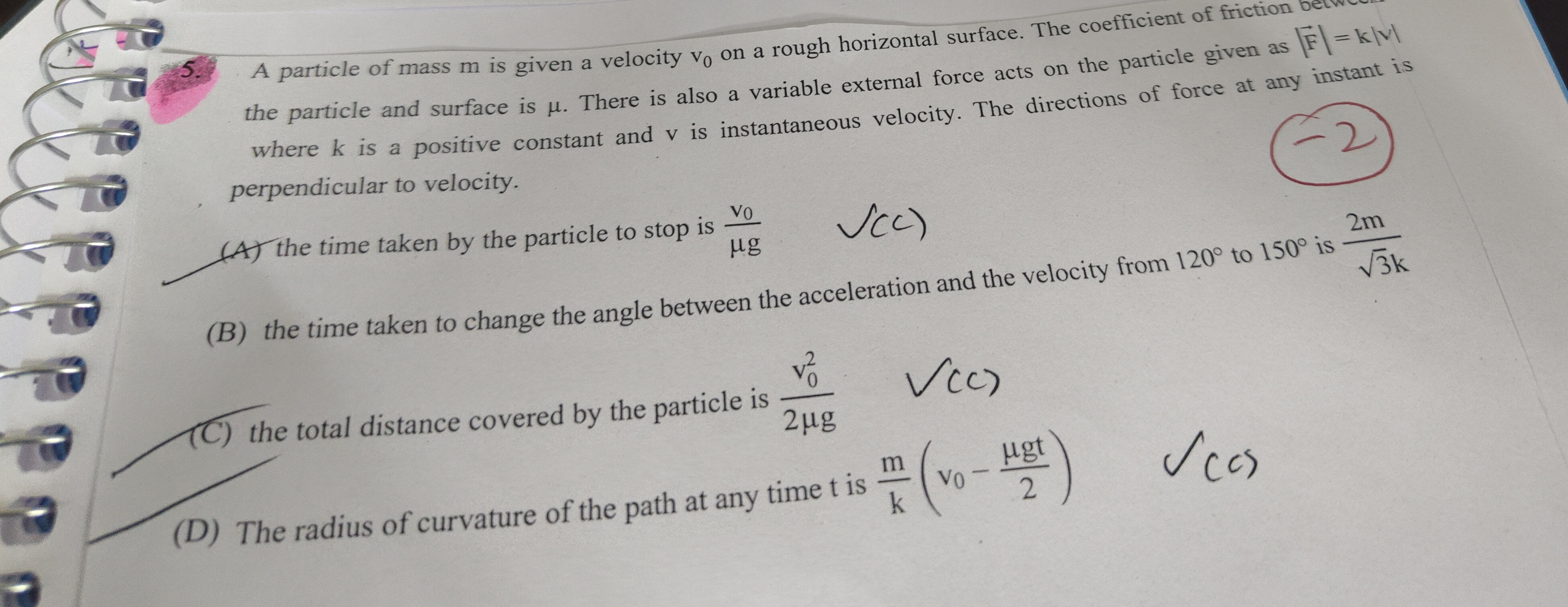Question
Question: A particle of mass m is given a velocity $v_0$ on a rough horizontal surface. The coefficient of fri...
A particle of mass m is given a velocity v0 on a rough horizontal surface. The coefficient of friction between the particle and surface is μ. There is also a variable external force acts on the particle given as ∣F∣=k∣v∣ where k is a positive constant and v is instantaneous velocity. The directions of force at any instant is perpendicular to velocity.

the time taken by the particle to stop is μgv0
the time taken to change the angle between the acceleration and the velocity from 120∘ to 150∘ is 3k2m
the total distance covered by the particle is 2μgv02
The radius of curvature of the path at any time t is km(v0−2μgt)
A, B, C
Solution
The problem describes the motion of a particle under two forces: kinetic friction and a variable external force.
-
Kinetic Friction (fk): This force acts opposite to the direction of motion (tangential) and its magnitude is constant, fk=μN=μmg, where N is the normal force, equal to mg for a horizontal surface. This force causes deceleration.
-
Variable External Force (F): Its magnitude is given as F=kv, where v is the instantaneous speed. Its direction is always perpendicular to the velocity. This means the force acts as a centripetal force, changing the direction of motion but not the speed.
Let's analyze the acceleration components:
-
Tangential acceleration (at): This component is responsible for changing the speed of the particle. It is due to the friction force. mat=−fk⟹mdtdv=−μmg at=dtdv=−μg (constant deceleration)
-
Normal (Centripetal) acceleration (an): This component is responsible for changing the direction of the particle's velocity, causing it to move in a curved path. It is due to the external force F. man=F⟹man=kv an=mkv
Now let's evaluate each option:
(A) The time taken by the particle to stop is μgv0
From the tangential acceleration equation: dtdv=−μg Integrating with initial velocity v0 at t=0: ∫v0vdv=∫0t−μgdt v−v0=−μgt v(t)=v0−μgt The particle stops when v(t)=0. Let tstop be this time. 0=v0−μgtstop tstop=μgv0 This statement is correct.
(C) The total distance covered by the particle is 2μgv02
The distance covered is s=∫0tstopv(t)dt. s=∫0v0/μg(v0−μgt)dt s=[v0t−21μgt2]0v0/μg s=v0(μgv0)−21μg(μgv0)2 s=μgv02−21μgμ2g2v02 s=μgv02−2μgv02 s=2μgv02 This statement is correct.
(B) The time taken to change the angle between the acceleration and the velocity from 120∘ to 150∘ is 3k2m
Let v be the velocity vector. The tangential acceleration at is opposite to v (due to friction), so the angle between at and v is 180∘. The normal acceleration an is perpendicular to v. The total acceleration a=at+an. Let θ be the angle between a and v. Consider a right triangle formed by the magnitudes at=μg and an=mkv. The angle α between a and at (which is in the direction of −v) is given by: tanα=atan=μgkv/m=μmgkv Since at is in the direction opposite to v, the angle θ between a and v is θ=180∘−α. So, tan(180∘−θ)=tanα=μmgkv. Since tan(180∘−θ)=−tanθ, we have: tanθ=−μmgkv
For θ1=120∘: tan120∘=−3 So, −3=−μmgkv1⟹v1=k3μmg
For θ2=150∘: tan150∘=−31 So, −31=−μmgkv2⟹v2=3kμmg
The time taken to change the speed from v1 to v2 is Δt. Using v2=v1−μgΔt: Δt=μgv1−v2 Δt=μg1(k3μmg−3kμmg) Δt=km(3−31) Δt=km(33−1) Δt=3k2m This statement is correct.
(D) The radius of curvature of the path at any time t is km(v0−2μgt)
The radius of curvature R is related to the normal acceleration an and speed v by the formula: an=Rv2 So, R=anv2. We know an=mkv. Substituting an: R=kv/mv2=kvmv2=kmv Now, substitute the expression for v(t): R(t)=km(v0−μgt) Comparing this with the given option: km(v0−2μgt), we see they are different. This statement is incorrect.
Therefore, options (A), (B), and (C) are correct.
